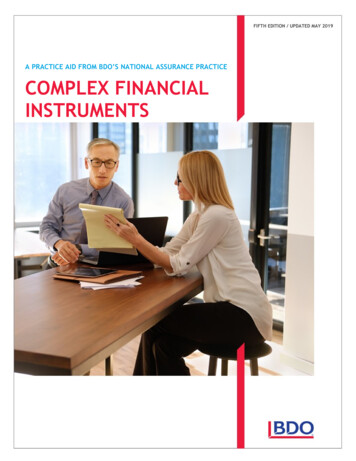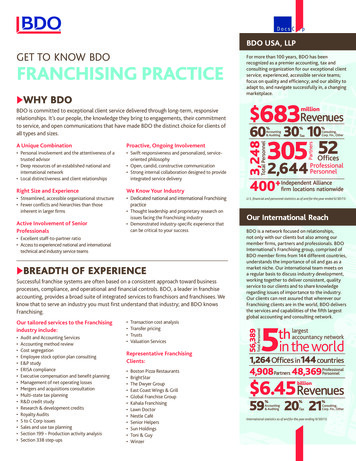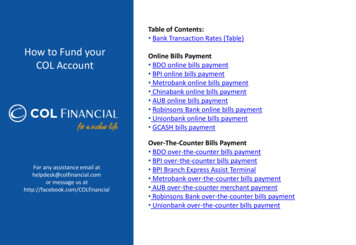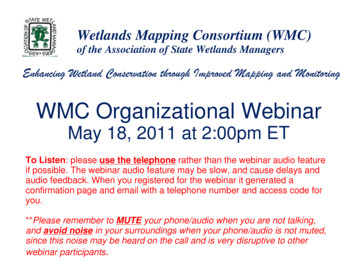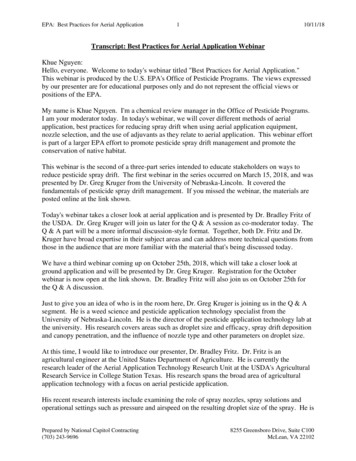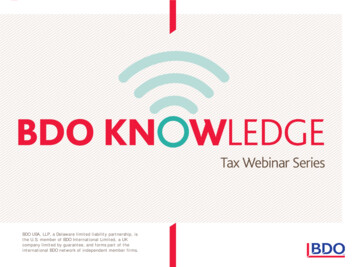
Transcription
BDO USA, LLP, a Delaware limited liability partnership, isthe U.S. member of BDO International Limited, a UKcompanylimited by guarantee,and formsof theBDO KNOWLEDGETax WebinarSeriespart‒ FinalIRC §263(a) Tangible Property Regulations: Technical Updateinternational BDO network of independent member firms.Page 1
Final IRC §263(a) Tangible Property RegulationsTechnical UpdateNathan Clark, CPA ‒ Senior Director, Fixed Asset Advisory Services, BDO USA, LLPMarla Miller, CPA ‒ Senior Director, Fixed Asset Advisory Services, BDO USA, LLPOctober 2, 2013BDO USA, LLP, a Delaware limited liability partnership, isthe U.S. member of BDO International Limited, a UKcompany limited by guarantee, and forms part of theinternational BDO network of independent member firms.
CPE AND SUPPORTCPE Participation Requirements ‒ To receive CPE credit for this webcast: You’ll need to actively participate throughout the program. Be responsive to at least 75% of the participation pop-ups.Certificate of Attendance:If you are logged in the entire time and respond to all participation pop-ups, you will be able to print yourcertificate from the “Participation” section at the end of the webcast. If you log out before printing yourcertificate: BDO USA professionals ‒ CPE will automatically be issued in CPE Tracking & Reporting at the end ofevery week. A copy of your certificate will be sent after you have been issued credit. All others will be emailed instructions on how to access your certificate.BDO KNOWLEDGE Tax Webinar Series ‒ Final IRC §263(a) Tangible Property Regulations: Technical UpdatePage 3
CPE AND SUPPORT (CONTINUED)Group Participation ‒ To receive credit: Sign-in sheets must list a Proctor name and CPA license number. BDO USA professionals ‒ Submit your sign-in sheets using a General Training & Development Request inBDO Service Now found at: BDOWorld Applications & Resources BDO Service Now Click “ServiceCatalog” in the left menu, then under Training & Development, “Make a Request”. Clients and contacts ‒ Email sign-in sheets to cpe@bdo.com within 24 hours of the webcast. Alliance members ‒ Should proctor their own group participants. This process is detailed in the LearnLiveParticipant Guide, which can be found by searching “LearnLive Participant Guide” on the Alliance Portal.Call LearnLive Support below for questions. Unfortunately, we cannot currently support group CPE for International Firms. Those wanting CPE mustregister and log in on their own computer.Q&A:Submit all questions using the Q&A feature on the lower right corner of the screen. At the end of thepresentation, the presenter(s) will review and answer all questions submitted.Technical Support:If you should have technical issues, please contact LearnLive: Click on the Live Chat icon under the Support tab, OR Call: 1-888-228-4088.BDO KNOWLEDGE Tax Webinar Series ‒ Final IRC §263(a) Tangible Property Regulations: Technical UpdatePage 4
WITH YOU TODAYNathan Clark, CPASenior Director ‒ Fixed AssetAdvisory ServicesBDO USA, LLPMarla Miller, CPASenior Director ‒ Fixed AssetAdvisory ServicesBDO USA, LLP1001 Morehead Square DriveSuite 300Charlotte, NC 28203Direct: (704) 887-4205Fax: (704) 887-4290nclark@bdo.com@ NathanPClark1700 Market Street29th FloorPhiladelphia, PA 419103Direct: (215) 636-5520Fax: (215) 636-5501mmiller@bdo.comBDO KNOWLEDGE Tax Webinar Series ‒ Final IRC §263(a) Tangible Property Regulations: Technical UpdatePage 5
TABLE OF CONTENTS Introduction De Minimis Expensing Rule Materials and Supplies Acquisition or Production of New Property Unit of Property Capitalization Standards Dispositions Other ConsiderationsBDO KNOWLEDGE Tax Webinar Series ‒ Final IRC §263(a) Tangible Property Regulations: Technical UpdatePage 6
INTRODUCTIONLegislative HistoryOn September 13, 2013, the IRS and Treasury Department released final regulations thataffect the treatment of materials and supplies, capitalization of amounts paid to acquire orproduce tangible property, and the capitalization and deduction of expenditures relating torepair or improvement of tangible property. The IRS also released proposed dispositionregulations. These regulations will have implications on most taxpayers regardless ofindustry.Below is the recent history of these regulations Proposed regulations issued August 18, 2006 Re-proposed regulations issued March 7, 2008 Temporary and proposed regulations issued December 23, 2011 Final and new proposed regulations issued September 13, 2013BDO KNOWLEDGE Tax Webinar Series ‒ Final IRC §263(a) Tangible Property Regulations: Technical UpdatePage 7
INTRODUCTIONTransition Rules Revenue Procedures with accounting method transition guidance expected to be releasedbefore year end, possibly in October Anticipate simplified procedures for change of accounting methods Mandatory application of final regulations in 2014 Transition years 2012 and 2013:‒ Option to adopt to apply final regulations retroactively to 2012 and/or 2013‒ Apply temporary regulations to 2012 and/or 2013‒ Apply existing law to 2012 and 2013BDO KNOWLEDGE Tax Webinar Series ‒ Final IRC §263(a) Tangible Property Regulations: Technical UpdatePage 8
FINAL TANGIBLE PROPERTY REGULATIONSSignificant ChangesThe following are significant changes between the temporary and final regulations: De Minimis Rule: 5,000 per item book-conformity safe harbor Materials and Supplies: Definition increased amount to 200 Routine maintenance safe harbor: Extended application to real property (with tenyear testing period) Small business relief for yearly improvements ‒ 10,000 test Annual election to follow book capitalization policy Disposition rules significantly modifiedBDO KNOWLEDGE Tax Webinar Series ‒ Final IRC §263(a) Tangible Property Regulations: Technical UpdatePage 9
De Minimis Expensing Rule:§1.263(a)-1(f)BDO KNOWLEDGE Tax Webinar Series ‒ Final IRC §263(a) Tangible Property Regulations: Technical UpdatePage 10
DE MINIMIS EXPENSING RULESafe Harbor Ceiling in 2011 temporary regulations replaced with a safe harborNew! Required to have a written policy at the beginning of the taxable year expensing amountspaid for:‒ Property costing less than a specified dollar amount, or‒ Property with a useful life of 12 months or less Expense in applicable financial statement (AFS) in accordance with the written policy Amount paid for the property does not exceed 5,000 per invoice (or per item, ifsubstantiated on the invoice) If no AFS, then replace the 5,000 amount with 500 per invoice/itemBDO KNOWLEDGE Tax Webinar Series ‒ Final IRC §263(a) Tangible Property Regulations: Technical UpdatePage 11
DE MINIMIS EXPENSING RULESafe Harbor Considerations Election requires the inclusion of materials and supplies except for:‒ Rotable, temporary and standby emergency spare parts that a taxpayer elects tocapitalize and depreciate‒ Rotable and temporary spare parts for which the optional method has been elected Transaction and additional costs (e.g., delivery fees, installation costs) are included ifidentified on the same invoice as the property 263A applies to amounts expensed under the de minimis rule Requires an annual, irrevocable tax return election May be applied at the “group” level May amend for 2012 and 2013 if written policy was in place Not intended to prevent a taxpayer from reaching an agreement with the IRS if clearreflection of incomeBDO KNOWLEDGE Tax Webinar Series ‒ Final IRC §263(a) Tangible Property Regulations: Technical UpdatePage 12
DE MINIMIS EXPENSING RULESafe Harbor Election Statement must be attached annually to a timely filed (including extensions)income tax returnNew! Statement must be titled “Section 1.263(a)-1(f) de minimis safe harbor election” andcontain the following information:‒ Taxpayer’s name‒ Address‒ Taxpayer identification number‒ Statement that the taxpayer is making the de minimis safe harbor election underSection 1.263(a)-1(f) Parent must list the names and tax identification numbers of each group member makingthe electionBDO KNOWLEDGE Tax Webinar Series ‒ Final IRC §263(a) Tangible Property Regulations: Technical UpdatePage 13
Materials and Supplies:§1.162-3BDO KNOWLEDGE Tax Webinar Series ‒ Final IRC §263(a) Tangible Property Regulations: Technical UpdatePage 14
MATERIALS AND SUPPLIESDefinitionTangible property that is used or consumed in the taxpayer’s operations that is not inventoryand: Is a component acquired to maintain, repair, or improve a unit of property owned,leased or serviced by the taxpayer and that is not acquired as part of any single unitof tangible property Consists of fuel, lubricants, water and similar items that are reasonably expected tobe consumed in 12 months or less Is a unit of property that has an economic useful life of 12 months or less, beginningwhen the property is used or consumed Is a unit of property that has an acquisition or production cost of 200or less Is identified in published guidance as a material and supplyBDO KNOWLEDGE Tax Webinar Series ‒ Final IRC §263(a) Tangible Property Regulations: Technical UpdatePage 15New!
MATERIALS AND SUPPLIESTreatment General rule remains the same:‒ Incidental materials and supplies are deductible in the year purchased‒ Non-incidental materials and supplies are deductible when used or consumed New provisions:New!‒ New definition for “standby emergency spare parts”‒ Election to capitalize and depreciate materials and supplies is permitted only forrotable, temporary, or standby emergency spare parts‒ Optional Method election permitted for rotable and temporary spare parts‒ Deduct any material and supply in the year purchased if de minimis safe harborelection is made (excluding amounts under the above two elections)BDO KNOWLEDGE Tax Webinar Series ‒ Final IRC §263(a) Tangible Property Regulations: Technical UpdatePage 16
Acquisition or Production of Property:§1.263(a)-2BDO KNOWLEDGE Tax Webinar Series ‒ Final IRC §263(a) Tangible Property Regulations: Technical UpdatePage 17
ACQUISITION OR PRODUCTION OF PROPERTY§1.263(a)-2A taxpayer must capitalize costs incurred to acquire or produce a unit of real or personalproperty.BDO KNOWLEDGE Tax Webinar Series ‒ Final IRC §263(a) Tangible Property Regulations: Technical UpdatePage 18
Unit of Property:§1.263(a)-3(e)BDO KNOWLEDGE Tax Webinar Series ‒ Final IRC §263(a) Tangible Property Regulations: Technical UpdatePage 19
IMPROVEMENTS TO PROPERTYApplicationUnit of PropertyImprovementsto PropertySafe Harborfor RoutineMaintenanceBDO KNOWLEDGE Tax Webinar Series ‒ Final IRC §263(a) Tangible Property Regulations: Technical UpdatePage 20Disposition
UNIT OF uralComponentsPlumbingBDO KNOWLEDGE Tax Webinar Series ‒ Final IRC §263(a) Tangible Property Regulations: Technical UpdatePage 21
UNIT OF PROPERTYCommon Examples of Building System ComponentsBuilding Unit(s) of Property and Common ComponentsBuildingStructureHeatingVentilationand Air“HVAC” Roof Walls Motors Floors Compress. Ceilings Foundation Boilers Furnace Chillers Pipes Ducts ors Pipes Drains Valves Sinks Bathtubs Toilets Water andSanitarySewerCollectionEquip. WaterUtilityEquip. Wiring ElevatorOutletsboxes Junctions Controlequipment LightingFixtures & Cables andConnectors movementequipment Elec.UtilityEquip.AllEscalators Rails Steps SupportingEquipment ControlsFireProtectionand AlarmSystems Sensing &DetectionDevices ComputerControls SprinklerHeads &Mains Piping &Plumbing Alarms ControlPanels SignageBDO KNOWLEDGE Tax Webinar Series ‒ Final IRC §263(a) Tangible Property Regulations: Technical UpdatePage 22SecurityGas Distr.Systems to SystemProtectBuilding and PipesOccupants Gas UtilityEquipment Window &Door Locks SecurityCameras Recorders Monitors MotionDetectors SecurityLighting Alarms EntryAccess
UNIT OF PROPERTYReal PropertyBDO KNOWLEDGE Tax Webinar Series ‒ Final IRC §263(a) Tangible Property Regulations: Technical UpdatePage 23
UNIT OF PROPERTYLeased, Co-op or Condo PropertyBDO KNOWLEDGE Tax Webinar Series ‒ Final IRC §263(a) Tangible Property Regulations: Technical UpdatePage 24
UNIT OF PROPERTYProperty Other than BuildingsGeneral Rule: FunctionalInterdependencePlant Property: Discrete andMajor FunctionNetwork AssetsBDO KNOWLEDGE Tax Webinar Series ‒ Final IRC §263(a) Tangible Property Regulations: Technical UpdatePage 25
UNIT OF PROPERTYPersonal PropertyBDO KNOWLEDGE Tax Webinar Series ‒ Final IRC §263(a) Tangible Property Regulations: Technical UpdatePage 26
UNIT OF PROPERTY EXAMPLESReal PropertyReal PropertyExpenditureUOPRetail Store ‒ Stand-aloneStore Refresh ‒ LightingreplacementElectrical systemRetail store ‒ Shopping Mall(leased space)Store Refresh ‒ LightingreplacementLeased portion of buildingelectrical systemOffice ‒ Owned buildingRemove conference room wallBuilding structureOffice ‒ Leased spaceRemove conference room wallBuilding structure within leasedspaceManufacturing PlantRoof replacementBuilding StructureApartment BuildingSingle Unit Heat/AirreplacementBuilding HVAC SystemBDO KNOWLEDGE Tax Webinar Series ‒ Final IRC §263(a) Tangible Property Regulations: Technical UpdatePage 27
UNIT OF PROPERTY EXAMPLESPersonal PropertyPersonal Property: Non-BuildingExpenditureUOPRestaurant ovenBurner replacementOvenGarbage truckEngine repair /replacementTruckApartment unit furnishingsNew carpet for individualunitCarpetDonut bakery manufacturing line ‒Interconnected mixers, ovens, conveyers, loafslicer, packagingKnife replacement /sharpeningSlicer componentRetail Donut Store Bakery ‒ Interconnectedmixers, ovens, conveyers, loaf slicer, packagingKnife replacement /sharpeningEntire baking lineBoiler tube replacementBoiler ‒ Refer to IndustryGuidance Rev. Proc. 201324Power Plant ‒ Coal pulverizers, boilers, turbine,and a generatorBDO KNOWLEDGE Tax Webinar Series ‒ Final IRC §263(a) Tangible Property Regulations: Technical UpdatePage 28
Capitalization Standards:§1.263(a)-3BDO KNOWLEDGE Tax Webinar Series ‒ Final IRC §263(a) Tangible Property Regulations: Technical UpdatePage 29
IMPROVEMENTS TO PROPERTYBettermentAdaptationRestorationBDO KNOWLEDGE Tax Webinar Series ‒ Final IRC §263(a) Tangible Property Regulations: Technical UpdatePage 30
IMPROVEMENTS STANDARDS“BAR”Apply the following tests to the UOP to determine whether the expenditure is a capitalexpenditure:BDO KNOWLEDGE Tax Webinar Series ‒ Final IRC §263(a) Tangible Property Regulations: Technical UpdatePage 31
CASUALTY LOSS RULERestorations Elective casualty loss or current-year repair deduction has been removed Amount required to be capitalized as a restoration of damage to a UOP is limited to theexcess of‒ The adjusted basis in the single identified property at the time of the casualtyover‒ Amount paid for the restoration of damage to the UOP from the casualty thatwould otherwise be a capital improvement Total deduction between the Section 165 casualty loss and repairs cannot exceed out-ofpocket costs incurred in the year of the casualty eventBDO KNOWLEDGE Tax Webinar Series ‒ Final IRC §263(a) Tangible Property Regulations: Technical UpdatePage 32
ROUTINE MAINTENANCE SAFE HARBORReal and Personal PropertyAmount paid is deemed NOT to improve the UOP if it is for the recurring activities that ataxpayer expects to perform as a result of the taxpayer’s use of the UOP “to keep” the UOPin its ordinarily efficient operating condition Routine maintenance for non-building property: activity is expected to be performedmore than once during the ADS class life Expanded to include routine maintenance for building property ‒ Substitute10-year period for ADS class life Does not apply to:New!‒ Betterments‒ Restoration standards relating to loss on replaced component, casualty loss,and restoration from a state of disrepair‒ Network assets‒ Certain rotable spare partsBDO KNOWLEDGE Tax Webinar Series ‒ Final IRC §263(a) Tangible Property Regulations: Technical UpdatePage 33
SMALL TAXPAYERSSafe HarborNew Safe harbor provided for small taxpayers:New! Election to not capitalize repairs, maintenance, or improvements Applies to taxpayers with three-year average gross receipts not to exceed 10M Applies to owned or leased buildings with unadjusted basis not to exceed 1M Total amount paid during the tax year for repairs, maintenance, and improvementscannot exceed the lessor of:‒ 2% of the unadjusted basis of the building, or‒ 10,000BDO KNOWLEDGE Tax Webinar Series ‒ Final IRC §263(a) Tangible Property Regulations: Technical UpdatePage 34
BOOK CAPITALIZATION ELECTIONElection to Follow Book New!Taxpayers may elect to capitalize repair and maintenance consistent with thosecapitalized on its books and records Annual election to treat repairs and maintenance as improvements, Election applies to ALL amounts paid for repairs and maintenance that are capitalizedon the taxpayers books and records. Election is irrevocable Amounts expensed on books and records remain subject to the Code and regulationsand must be analyzed for compliance May elect back to 2012 through amended returnsBDO KNOWLEDGE Tax Webinar Series ‒ Final IRC §263(a) Tangible Property Regulations: Technical UpdatePage 35
BETTERMENT EXAMPLES A retail chain refreshes its stores to maintain the appearance and functionality of its storebuildings after several years of wear. The work consists of replacing and reconfiguringdisplay tables and racks to provide better exposure of the merchandise, lightingrelocations, flooring repairs, moving one wall to accommodate the reconfigured tables,patching holes in walls, repainting, replacing ceiling tiles, cleaning flooring, and powerwashing the building. The display tables and racks constitute 1245 property. The refresh isNOT a BETTERMENT because it did not materially increase the productivity, efficiency,strength, quality, or output of the building structure or system. Taxpayer must capitalizethe amounts paid for the 1245 property [Example 6] Same as above, except the taxpayer also pays amounts to increase the storage space, adda loading dock, a second overhead door, and upgrades to the electrical system at thesame time as the refresh. Amounts paid for the above are deemed BETTERMENTS and mustbe capitalized. However, for reasons discussed in Example 6, taxpayer is not required totreat the amounts paid for the refresh as a betterment [Example 7]BDO KNOWLEDGE Tax Webinar Series ‒ Final IRC §263(a) Tangible Property Regulations: Technical UpdatePage 36
BETTERMENT EXAMPLES (CONTINUED) Taxpayer owns a retail chain. Due to changes in the retail market, taxpayer decides toupgrade its stores to offer higher end products. Taxpayer substantially remodels its storesincluding replacing large parts of the exterior walls with windows, replacing the escalatorswith monumental staircase, adding a new glass enclosed elevator, rebuilding the interiorand exterior facades, replacing vinyl floors with ceramic flooring, replacing ceiling tileswith acoustical tiles, and removing and rebuilding walls to move changing rooms andcreate specialty departments. The work also includes upgrades to the electrical system,including mood enhancing lighting fixtures. In addition, all of the bathrooms wereremodeled by replacing contractor-grade plumbing with designer-grade fixtures thatconserve water and energy. Finally, taxpayer paid amounts to clean debris, patch holes inwalls that were made to upgrade the electrical system, repaint existing walls with a newcolor scheme to match the new interior construction, and to power wash buildingexteriors to enhance the new façade. Taxpayer must capitalize the above items as aBETTERMENT [Example 8]BDO KNOWLEDGE Tax Webinar Series ‒ Final IRC §263(a) Tangible Property Regulations: Technical UpdatePage 37
ADAPTATION EXAMPLES X owns a building consisting of retail spaces that were designed to be reconfigured. Onetenant wishes to expand its occupancy to include two adjoining retail spaces. X pays anamount to remove the walls between the three retail spaces. Assume the walls betweenspaces are part of the building and its structural components. Amounts paid to convert theretail spaces into one larger space for a tenant DOES NOT ADAPT X’s building structure toa new or different use and is not required to be capitalized. [Example 2] Taxpayer owns a grocery store. Taxpayer decides to add a sushi bar for its customers.Expenditures were made for counter and chairs, additional wiring and outlets, additionalpipes and a sink, replacement of flooring and wallcoverings. The amount paid to convertpart of the retail grocery to a sushi bar is NOT an ADAPTATION. The sale of sushi isconsistent with the taxpayer’s intended, ordinary use of the building structure and thesystems in the grocery sales business, which includes selling food to its customers atvarious specialized counters. [Example 6]BDO KNOWLEDGE Tax Webinar Series ‒ Final IRC §263(a) Tangible Property Regulations: Technical UpdatePage 38
RESTORATION EXAMPLESRESTORATION ‒ Major component/substantial structural part: Replacement of the entire roof (decking, insulation) [Example 14] Replace chiller in office HVAC system (consists of one chiller, one boiler, pumps, duct work,diffusers, air handlers) [Example 16] Sprinkler system in a building [Example 19] Replace wiring throughout the building to meet building code [Example 20] Retail business replaces the plumbing fixtures in all of its restrooms (no piping) ‒ Two floors[Example 22] Hotel replaces all bathtubs, sinks in hotel rooms in four of the 20 floors; intends tocomplete renovation of the remaining rooms over next two years [Example 23] Replaces 200 of the 300 exterior windows (total windows are 25% of the building surfacearea [Example 26] Replaces 100 of 300 windows, but the windows cover 90% of the building surface [Example27] Replace all floors in the public areas of a hotel ‒ Public areas represent 40% sq ft [Example29]BDO KNOWLEDGE Tax Webinar Series ‒ Final IRC §263(a) Tangible Property Regulations: Technical UpdatePage 39
RESTORATION EXAMPLES (CONTINUED)NOT RESTORATION ‒ Not a major component/substantial structural part: Replacement of roof waterproof rubber membrane [Example 15] Replacement of one furnace ‒ HVAC system consists of three furnaces, duct work,etc. [Example 16] Replacement of three of 10 rooftop units in HVAC system ‒ HVAC system consists of10 rooftop units, ductwork, etc. [Example 18] Replace 30% of wiring to meet building code [Example 21] Replace eight of 20 sinks in restrooms in a retail store (no piping) [Example 23] Replace 100 of 300 exterior windows (windows cover 25% of exterior surface)[Example 25] Replace flooring in lobby ‒ 10% of the sq. ft. of the entire hotel building [Example29]BDO KNOWLEDGE Tax Webinar Series ‒ Final IRC §263(a) Tangible Property Regulations: Technical UpdatePage 40
MACRS DispositionsBDO KNOWLEDGE Tax Webinar Series ‒ Final IRC §263(a) Tangible Property Regulations: Technical UpdatePage 41
DISPOSITIONSOverview of Proposed RegulationsNew! Comments must be received by November 12, 2013 May be relied upon for the 2012 and 2013 tax years IRS and Treasury Department intend to publish final regulations in 2013 ‒ The finalregulations are expected to apply to tax years beginning on or after January 1, 2014BDO KNOWLEDGE Tax Webinar Series ‒ Final IRC §263(a) Tangible Property Regulations: Technical UpdatePage 42
DISPOSITIONA disposition of property occurs when the asset’s ownership is transferred or when the assetis permanently withdrawn from use either in the taxpayer’s trade or business or in theproduction of income.A disposition occurs when an asset is: Sold or exchange; Retirement; Physically abandoned; Destruction (including casualty); Transferred to a supplies, scrap, or similar account; Involuntary conversion; or Disposition of a portion of an asset as a result of a casualty event, like-kindexchange, involuntary conversion, sale of a portion or an asset, or a “partialdisposition” electionBDO KNOWLEDGE Tax Webinar Series ‒ Final IRC §263(a) Tangible Property Regulations: Technical UpdatePage 43New!
PARTIAL DISPOSITION ELECTIONNew! Taxpayers may elect to treat a partial disposition of an asset as a disposition Taxpayer claims a loss upon the disposition of a structural component (or a portionthereof) of a building without identifying the component as an asset before the dispositionevent The election is made on a timely filed return “including extensions” in the taxable year inwhich the disposition occurs Partial disposition rule is mandatory in certain cases (casualty event, like-kindexchange, involuntary conversions) Proposed regulations provide simplified method for determining adjusted basis ofdisposition, including discounted replacement cost, replacement cost of partial dispositionas a percentage of replacement cost, cost segregations. There no longer is a consistencyrequirement Amend return or method change for 2012 and 2013BDO KNOWLEDGE Tax Webinar Series ‒ Final IRC §263(a) Tangible Property Regulations: Technical UpdatePage 44
GENERAL ASSET ACCOUNT (“GAA”)ElectionNew! Under the GAA, no loss on disposition recognized until all assets in the GAA have beendisposed Definition for qualifying disposition more restrictive ‒ Limited to partial or completedisposition by casualty, charitable contribution, termination or sales of business, andcertain non-recognition transactions Use of GAA returns to prior law Do NOT make a GAA election if goal is to claim losses on partial replacements, includingbuilding structural componentsBDO KNOWLEDGE Tax Webinar Series ‒ Final IRC §263(a) Tangible Property Regulations: Technical UpdatePage 45
Other ConsiderationsBDO KNOWLEDGE Tax Webinar Series ‒ Final IRC §263(a) Tangible Property Regulations: Technical UpdatePage 46
NEXT STEPS AND OTHER CONSIDERATIONS Analyze whether current policies are in compliance with the new capitalization standards Determine adequacy of written policy for the de minimis safe harbor BEFORE thebeginning of 1/1/14 Consider making the following elections:‒ De minimis safe harbor‒ Follow book capitalization method,‒ Capitalize as acquisition costs, the overhead and employee compensation costs‒ Capitalize and depreciate rotable, temporary, or standby emergency spareparts‒ Optional method of accounting for rotable and temporary spare parts‒ Routine maintenance safe harbor for buildings‒ Safe Harbor for Small Taxpayers‒ General Asset Accounts‒ Recognize gain or loss on partial dispositionsBDO KNOWLEDGE Tax Webinar Series ‒ Final IRC §263(a) Tangible Property Regulations: Technical UpdatePage 47
NEXT STEPS AND OTHER CONSIDERATIONS(CONTINUED) Consider ASC 740 financial reporting implications (e.g., FIN 48, disclosures) Consider future reduction/increase in tax rates Determine the accounting method changes required Revisit previous “repair” accounting method changes for revisions to conform to the finalrules Quantify potential tax savings for repairs/dispositions (cash flow) Develop sustainable processes and procedures to continue for future tax years Determine the most advantageous timing to comply with the regulationsBDO KNOWLEDGE Tax Webinar Series ‒ Final IRC §263(a) Tangible Property Regulations: Technical UpdatePage 48
Questions and DiscussionBDO KNOWLEDGE Tax Webinar Series ‒ Final IRC §263(a) Tangible Property Regulations: Technical UpdatePage 49
Speaker BiographiesBDO KNOWLEDGE Tax Webinar Series ‒ Final IRC §263(a) Tangible Property Regulations: Technical UpdatePage 50
BIOGRAPHYNathan Clark, CPANathan Clark, CPASenior Director ‒ Fixed AssetAdvisory ServicesBDO USA, LLP1001 Morehead Square DriveSuite 300Charlotte, NC 28203Direct: (704) 887-4205Fax: (704) 887-4290nclark@bdo.com@ NathanPClarkNathan has 15 years of public accounting experience,including nine years with a Big 4 firm, with a deep focuson capitalization and depreciation accounting methodchanges. His experience ranges from working with smallprivately held businesses to, publicly traded, Fortune500 companies. He has significant experience in retail,manufacturing, real estate, and hospitality industries,among others.Nathan regularly implements tangible propertyregulation accounting method change studies, as well asstudies focused on capitalization issues including, butnot limited to, reclassification, Sec. 174, bonusdepreciation, cost segregation, internally developedsoftware, and ready and available. He works with hisclients from identification and implementation throughIRS examination.In addition, Nathan implements custom solutions forclients with unique fixed asset concerns, such asdeferred reconciliation, acquisitions, and fixed assetsystem conversion planning / consulting.BDO KNOWLEDGE Tax Webinar Series ‒ Final IRC §263(a) Tangible Property Regulations: Technical UpdatePage 51
BIOGRAPHYMarla Miller, CPAMarla Miller, CPASenior Director ‒ Fixed AssetAdvisory ServicesBDO USA, LLP1700 Market Street29th FloorPhiladelphia, PA 419103Direct: (215) 636-5520Fax: (215) 636-5501mmiller@bdo.comMarla has more than twenty years of experience inboth the public and private sectors, practicing inthe areas of federal, and state and local tax. Shehas been involved in all aspects of the income taxfunction, including FIN 48, FAS 109, and the taxcompliance function. Marla has handled federal andstate tax examinations, including IRS JointCommittee and appeals cases. She also hasprovided consulting services in the areas of FixedAsset Reviews and Capital vs. Expense Reviews toboth multinational and domestic companies invarious industries, including real estate, financialservices, retail, food and beverage, and heavy andlight manufacturing.BDO KNOWLEDGE Tax Webinar Series ‒ Final IRC §263(a) Tangible Property Regulat
BDO KNOWLEDGE Tax Webinar Series ‒ Final IRC §263(a) Tangible Property Regulations: Technical Update Page 1 BDO USA, LLP, a Delaware limited liability partnership, is the U.S. member of BDO International Limited, a UK company limited by guarantee, and forms part of the
